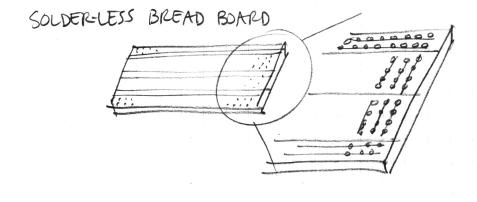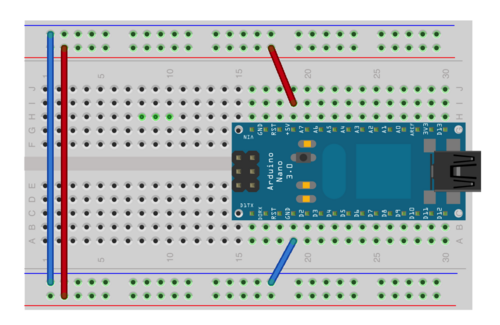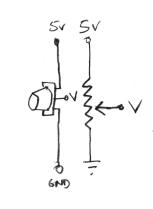Tangible Embedded Linux: Difference between revisions
No edit summary |
No edit summary |
||
| Line 6: | Line 6: | ||
* A pico projector with cable to HDMI connector. | * A pico projector with cable to HDMI connector. | ||
Prior to coming to the workshop, you may wish to read more about [https://ccrma.stanford.edu/satellite Satellite CCRMA], [puredata.info Pure Data], [www.raspberrypi.org Raspberry Pi], or the [http://arduino.cc/en/Main/ArduinoBoardNano Arduino Nano]. | |||
Revision as of 20:37, 6 February 2013
This workshop consists of a condensed version of the material from labs 1 and 2 for the course Music 250A at Stanford University. For this workshop you need your Satellite CCRMA kit, a laptop computer with Ethernet adaptor to program it, and some headphones with a mini 1/8" (2.54mm) stereo jack.
You are also invited to bring the following optional items, but they are by no means required:
- Some of your favorite breadboardable sensors and LEDs.
- A set of small, battery powered speakers with 1/8" (2.54mm) jack.
- A pico projector with cable to HDMI connector.
Prior to coming to the workshop, you may wish to read more about Satellite CCRMA, [puredata.info Pure Data], [www.raspberrypi.org Raspberry Pi], or the Arduino Nano.
Introductions
- Participants explain their backgrounds and what they would like to get out of the studio.
- Show some videos of prior projects
- Construct Satellite CCRMA kits
Powering Up For The First Time
Plug the Ethernet port of the Satellite CCRMA into your laptop. Then use the USB micro cable to connect your laptop to the Raspberry Pi--this provides the power. You should see some lights turn on, flickering every now and then. This means that Satellite CCRMA is booting up.
Connect To Satellite CCRMA
In order to see what your Satellite CCRMA kit is doing and program it, you need to log in to it. To do so, follow these instructions.
After you login, you will see the prompt ccrma@satellite:~$ This means that you are logged into a computer named "satellite" as the user "ccrma", and you are currently in the directory ~, which is the shortcut for your home directory.
Stop Default Patch and Run Pd
- In order to be able to hear audio, you will need to plug a pair of ear buds, headphones, or loudspeakers into the 1/8" (2.54mm) jack labeled AUDIO OUT on the Raspberry Pi. Be careful when plugging the headphones in and not to pull too hard on the headphone cable!
- A default pd patch starts running automatically when your kit finishes booting up. To stop the default patch, run the command
stop-default
- Start pd now with the following command. The ampersand (&) is there to indicate that even though you are opening a new window, you should still be able to keep typing at the old terminal.
pd &
- To start audio, click on the Compute audio checkbox.
- Now to test audio, go to the media pull-down menu and choose Test Audio and MIDI. If you still do not here any sound, then probably you missed one of the steps so far. If you look at the messages in the main pd window, you might find a clue.
- Once you have audio working, close the window test audio and MIDI window.
Learn More About Pd
If you get stuck at some point while learning about pd, remember that you can right-click on an object to get help information about the object.
- The patch ~/pd/examples/just-play-WAV-files/play-WAV-file.pd shows the easiest way to play a WAV file.
- Look at the pd lecture patches stored in ~/pd/pd-lecture
Prepare Arduino
- The next step is to install some default firmware onto the Arduino so that it knows what we want it to do. Start the Arduino software in the terminal by typing
arduino &
- Open StandardFirmata from the Arduino software pull-down menus File|Examples|Firmata. Look at the program. This is what will control the Arduino.
- Select Arduino Nano w/ ATMega328 under Tools->Board and /dev/ttyUSB0 under Tools->Serial Port. Then hit the Play button to verify and compile the program.
- Upload the Firmata firmware to your Arduino Nano using upload button, the fourth square button from the left (the one with the sideways arrow). If you watch the RX and TX lights on the Arduino carefully, you will "see" the data flow over the serial USB link into the Arduino as the firmware is uploaded.
- Close the Arduino program by closing all of the Arduino windows. (This is important!)
Routing Power On The Breadboard
- Remind yourself about how the sockets on the breadboard are wired together:
- Now you are going to start putting jumper wires into your breadboard. Try to be careful to build the circuit correctly. (If you create a short circuit (one kind of wiring mistake), then the lights will instantly all go off on the Arduino. If this happens, please try to undo the short circuit right away.)
- Now connect jumper wires as shown in the image below so that the upper and lower long columns can serve as a power supply for your future circuits.
- Connect a short jumper from the GND pin of the Arduino to the blue column.
- Connect a short jumper from the 5V pin of the Arduino to the red column.
- Finally, use two longer jumpers to connect together the blue columns and the red columns as shown below:
- Check your wires again to make sure that you did it correctly!
Connect Your Analog Sensor To Pin A0
Each participant should have one analog sensor in his or her kit. Optionally go to one of the following links to learn more about electronics or sensors.
Force-Sensing Resistor
If you have a force-sensing resistor, you can hook it up to an analog input of the Arduino by building a voltage divider out of it with a 33k fixed resistor. The idea is that you put two resistors in series between power and ground: one that changes resistance (your sensor), and one of a known, fixed resistance. At the point in between the two resistors, you can measure how much the voltage has dropped through the first resistor. This value changes as the ratio of resistances between variable and fixed resistors change.
- force-sensitive resistor (FSR):
Soft-Pot
- If instead you have a soft-pot or a standard potentiometer, then you can wire it up this way:
Range Sensor
- If you have an infra-red range sensor, then connect the black wire to ground, the red wire to 5V (power), and connect the other wire directly to an analog input on the Arduino.
CyberDuck
You can use CyberDuck to get files
- Choose Open from the File menu and select the patch 4_algorithmic_music.pd. In the main pd-extended window, click on the compute audio button. Then go back to the patch, move the speed and width sliders slightly to the right, and bring up the volume. You should now hear some sound in your headphones. Play around with the parameters to see what new sounds you can discover.
Troubleshooting:
Learn A Lot More About Pd
- Here are some lists of pd objects that you can use to discover new object names: http://protman.com/content/list-puredata-objects-and-extended-objects http://www.umatic.nl/workshop/objects.txt
- Go to the Help pull-down menu, choose Browser, go into Pure Data (near the top), and then look through the demonstration pd patches that are organized into chapters.
- For even more further learning, see the labs from the Music 250A course, which are stored in ~/pd/labs-Music-250a-2012
Advanced demo patches for users who have a monitor or pico projector connected:
- The pd patches in ~/pd/examples/SimpleGraphicsOSC can be used to send OSC messages to the SimpleGraphics executable to render hardware-accelerated graphics.
- OR, the patch ~/pd/examples/just-play-video/trigger-omxplayer.pd can be used to trigger the playback of H.264 or MPEG2-encoded video clips.



